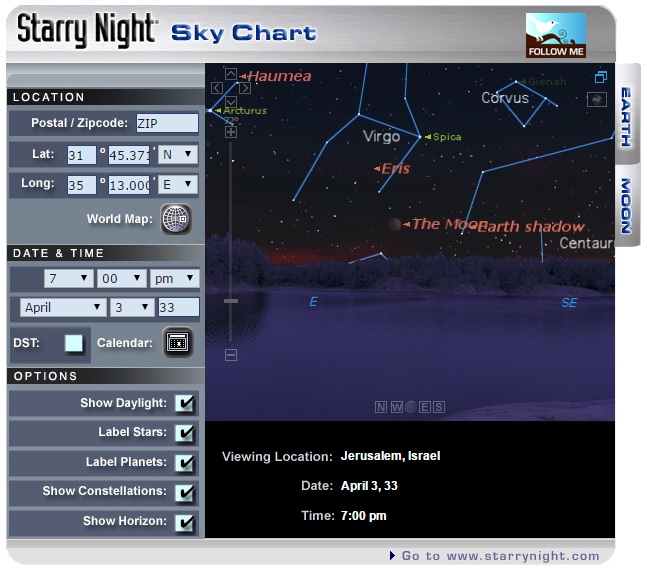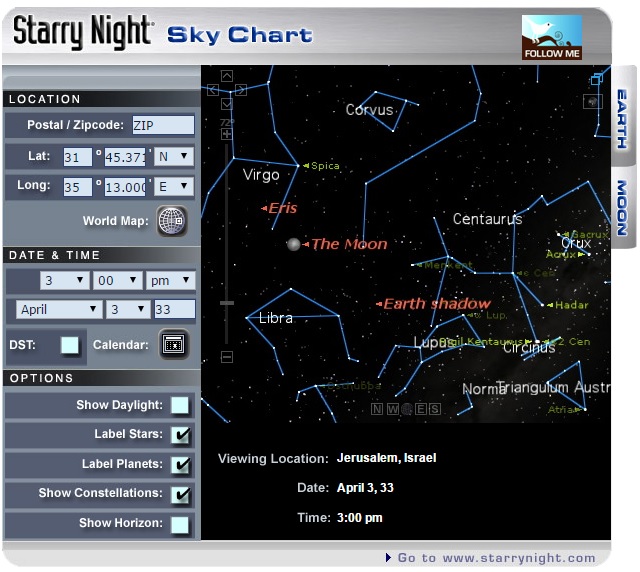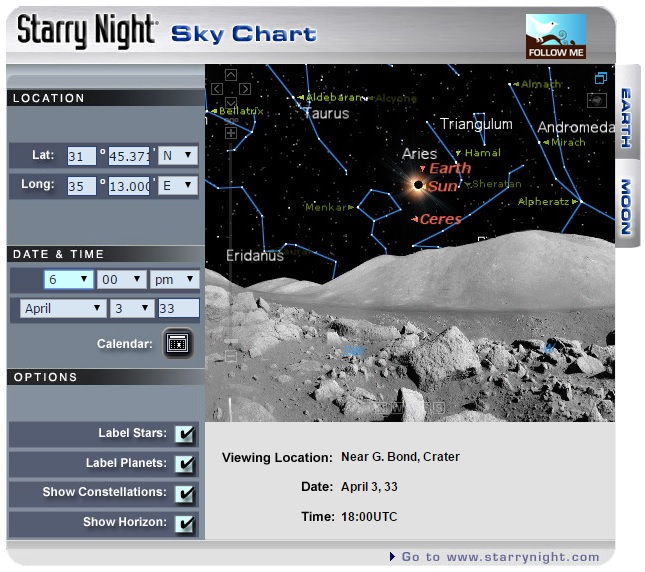This is definitely worth reposting.
The fellow who made the video about the Star of Bethlehem (a compelling argument, I might add), also did some research about what happened in the heavens on Good Friday.
Let’s break it down.
Passover begins on the 14th day of the Jewish lunar month of Nisan. Moreover, Passover begins at twilight, dividing 14 Nisan and 15 Nissan. The Gospels say the Lord was crucified on Preparation Day, a Friday. 14 Nisan 14 fell on a Friday Preparation Day, twice: 7 April AD 30 and 3 April AD 33. Daniel in 444 BC prophesied (Daniel 9:21–26) that the Anointed one would be cut off in 476 years after the decree to rebuild Jerusalem: AD 33.
The Bible records that, at the time of the crucifixion and death of the Lord, there were signs, including a “blood moon” or lunar eclipse.
Only one Passover lunar eclipse was visible from Jerusalem while Pilate was in office. It occurred on 3 April 33.
On 3 April the Moon rose already in eclipse. It rose the color of blood. That means that the eclipse began before it rose, in the constellation of the Virgin (at the time of Christ’s birth there was a New Moon, in the constellation of the Virgin).
The eclipse started at 3 pm when Christ was breathing His last.
But remember that a lunar eclipse is a syzygy!
If there is an eclipse in one direction there is an eclipse in the other direction too.
If you were standing on the Moon during that syzygy of 3 April 33, you would see a total eclipse of the Sun.
The blotted Sun would be in the heart of the constellation of the Ram (cf. “the Lamb who was slain”).
You can try this out for yourselves. Go to the online astronomy aid Starry Night. HERE
Move your location to Jerusalem and then plug in the time of about 7 pm and date 3 April 33 and adjust your view to ESE. You will see the Moon has just risen and there is a label for your Earth’s shadow. The Moon had risen at about 6:30 pm in the totality of the eclipse. HERE
With the daylight turned off, and the horizon removed, and then looking at an angle down through the Earth below the horizon, at 3 pm, you see the Moon and Earth’s shadow converging in Virgo.
Then you can switch to the view from the Moon!
You must adjust your view a little and turn yourself right with a few clicks. But you will find it. In the screenshot, below, you can see where Earth and Sun are in Aries. Since the Earth would be larger in the Moon’s sky than in this screenshot, the Sun would be in total eclipse. Adjust for UTC + 3 hours to the right time in Jerusalem from 1500 to 1800. HERE
In reading around the question a little more, I find that, using different date calculators, there are some problems of the day of the week. Also, there are arguments for dating the Crucifixion to 1 April 33. If that is the case, then the phenomena described above occur on Easter Sunday. Much hinges on which calendar the Lord and His disciples were using for their own Passover meal, if the last Supper was a Passover meal (Joseph Ratzinger argued that it was a related sacrificial meal but not a seder.)
[Subsequently, I’ve found more and convincing arguments about calendar debate. This debate revolves around a seeming contradiction between John and the synoptics. Some say that Christ anticipated a meal so that He would die at the same time as the paschal lambs. That is attractive. But it is also not true. His Last Supper was indeed the supper of the Passover, with the paschal lamb. The argument hinges on the fact that it was not only Passover time (and all the days that followed were also called “Passover”, as we say “Happy Easter” for days after Easter), it was going to be the sabbath, and so, in the time of Passover, was the “day of Preparation of the Passover” was really preparation for SABBATH that fell in that Passover “umbra”, if you will permit the pun.]
Definitive? Not quite. But it is not to be discounted that God, from all Eternity knowing exactly what would happen, set the heaven’s in motion in so precise a way that its signs would help us to understand the mysteries taking place, which were in other ways foreshadowed. In the sacraments (a term interchangable with “mystery” in many contexts), visible signs help us to understand that insensible graces and transformations are taking place. If in the signs of the sacraments, why not too signs in the heavens?




































Clear physical evidence – and yet how many of us have eyes that will not see? How much modern rediscovery of physical evidence does it take for us to stop regarding these as stories and not histories?
And there’s even another sign for those slower on the uptake, right here on “terra firma” that in fact wasn’t so firm that afternoon. This conference synopsis discusses earthquakes on April 3rd and April 5th, with evidence in Dead Sea mud layers indicating the epicenter was very near Jerusalem.
https://gsa.confex.com/gsa/2012AM/webprogram/Paper204688.html
God, please, remove the scales from my eyes more gently than that.
This old but useful article comes to the same conclusion: “Dating the Crucifixion,” by Colin J. Humphreys & W. G. Waddington, Nature, Vol. 306, 22/29 December 1983, pp. 743-46. The authors reference Acts 2:14-21, where St. Peter cites Joel 2:31, as further support of their conclusions, and hypothesize that a khamsin dust storm may have caused the darkening of the Sun at the crucifixion.
Shouldn’t we look a 34 A.D.? If Christ was born in December of 1 B.C. He would have turned 33 in December 33 A.D. then His Passion would have occurred in 34 A.D.
Here is a video from Dr. Brant Pitre on the dating of the Last Supper.
HERE
I always found Giuseppe Riccioti’s explanation of the difference of the dating of the Last Supper compelling. He explains (The Life of Christ, Riccioti, 566-568) that in the time of Christ, the Sadducees and the priestly class in general followed a different calendar than the Pharisees. The Sadducees said that Pentecost, and subsequently, certain Paschal offerings, must always be on a Sunday; while the Pharisees said the offering could be held on any day of the week. The Sadducees used to change their calendars, that is, literally make the dates different so they could make certain they always offered their gifts on Sunday. Calendars weren’t as rigid then as they are now, since certain feasts and dates followed the appearance of harvests and other physical signs. The Pharisees, and the people in general, did not change the calendar. Riccioti writes, “Because of this difference in opinion, the Boethians and in general the Sadducees used to rearrange their calendar, especially when the Pasch (fifteen Nisan) fell on Friday or Sunday. If it fell on Friday, they pushed the Calendar forward and made that Friday the day of the sacrifice of the lamb and the Paschal dinner (the fourteenth), celebrated the Pasch on Saturday, the Sabbath (the fifteenth), and made the offering of wheat on Sunday (the sixteenth). If the Pasch fell on Sunday, they pushed the calendar back a day or so so that the wheat offering would still be made on a Sunday…It was, as we have seen, an easy matter to doctor the calendar….[on the year Christ died, a Friday] the Sadducees, true to their principle, pushed the calendar back a day so that the offering of wheat would fall on a Sunday. The Pharisees, on the other hand, followed the regular calendar and made their wheat offering on that Sabbath. The people were divided between the two.” The Synoptics follow the calendar of the Pharisees, in this theory, and St. John follows the calendar of the Sadducees and the priests. This is made more compelling to me by John 18:16, which says that John is known well enough by the High Priest to invite Peter into the courtyard. If John, still a young man at the time, traditionally about eighteen years of age, was familiar with the High Priest and his household, so that he could bring Peter with him, it is likely he would have followed the High Priest’s calendar.
A postscript to me earlier comment: when I wrote (in too much haste) “The authors reference Acts 2:14-21, where St. Peter cites Joel 2:31, as further support of their conclusions …” I should have added “… St Peter (in his Pentecost day sermon) cites …” to what I wrote originally.
As to excalibur’s suggestion to look to 34 AD, that wouldn’t work, because in that year 14 Nisan would have fallen, most likely, on Wednesday, 24 March.
I repeat my commendation of the article from Nature. It is only four pages in length. I photocopied it yesterday, and mailed the copy to Fr. Z in Madison on my way to church yesterday evening.
The Essenes really need to be mentioned in all this, too. (They were the Jewish religious community based in Qumran, the same community with which St. John the Baptist was associated.) Along with the Pharisees and Sadducees, they made up the three largest movements within Judaism in Jerusalem at the time of Jesus. While the others used the Sanhedrin’s 354 day lunar calendar, the Essenes used a 364 day solar calendar which reset itself (Nisan 1) on the vernal equinox each year.
The 354 day lunar and 364 day solar calendars conflicted, and we’re a major tension between the Essenes and the rest of Judaism, but that’s a story for another time.
In 30 AD, the Essene date for Passover was one day before the Sanhedrin’s date for Passover. That was highly unusual.
Archaeologists and other researchers have very strong evidence that the “gate of the Essenes” in the ancient walls of Jerusalem at the time of Jesus was the gate into the Mount Zion are of the city, and that area was very likely an Essene area of the city at the time of Jesus.
Is this to say Jesus was an Essene? No, not at all. There would be little basis for that. It does make a compelling case, however, that the Lord used the difference in calendars to share the Last Supper with his disciples before his Passion, while also possibly tweaking the Sanhedrin by associating with the Essene calendar, perhaps a straw that broke the camel’s back.
As to the difficulty between the Synoptics and the Gospel of John, the Essene calendar illuminates statement in the Fourth Gospel quite well. Furthermore, if John the author of the Fourth Gospel is also John the beloved disciple, as scholarship supports but not definitively, the author of the Gospel of John was present at the Last Supper. The authors of the other three Gospels were not, but relied on the tradition handed down to them and the Holy Spirit. Something as confusing as competing calendars can easily be misunderstood. Given the many years between the events of the 30s AD and the writing of the other three Gospels, it is also understandable how an astronomical phenomena on the anniversary a few years later, could merge into the telling.
Dr. John Bergsma discusses the dating of the Last Supper and the Essene connection in chapter 7 of his book “Jesus and the Dead Sea Scrolls” and echoes some of what John, a reader here, wrote above.
His hypothesis is that Jesus observed the Passover according to the old solar calendar used by the Essenses and celebrated the Last Supper on Tuesday not Thursday. Furthermore, he argues that “it is virtually impossible that all these hearings, trials, and negotiations took place within only twelve hours between midnight Thursday and noon Friday – on the Passover, too! Some scholarly reconstructions would have us believe that – on the very day of the Judean Passover, the Judean religious authorities assemble as a legal court multiple times, underwent serious negotiations with the Roman governor and the Jewish king, gathered and instigated a mob, and had Jesus crucified, all within half a day, despite the fact that they had previously resolved not to arrest him on the feast (Mark 14:2) and that night trials and trials on feast days were forbidden in Jewish law (Mishnah Sanhedrin 4:1).
[*] Thus, Jesus “had observed Passover according to the old liturgical calendar, along with the Essenes, who had sympathies with Jesus and his disciples because of personal ties and a common opposition to the ruling parties. In this way, providentially, Jesus both gave himself sacramentally in the Upper Room on Passover and gave himself physically on the cross on Passover – each by a different calendar.”
He develops this more in his book. It’s something to consider.